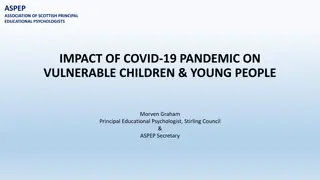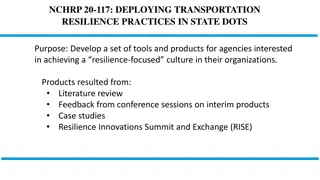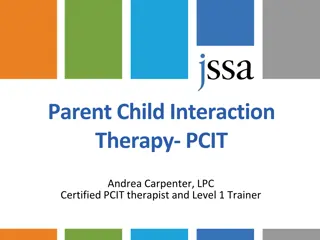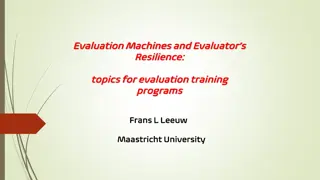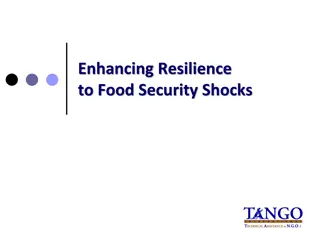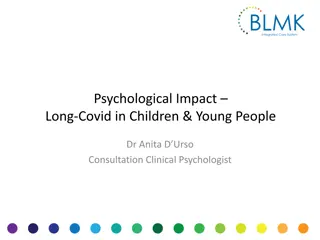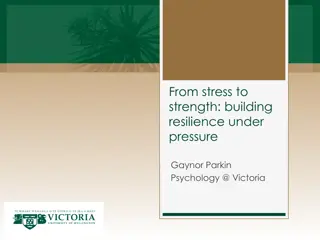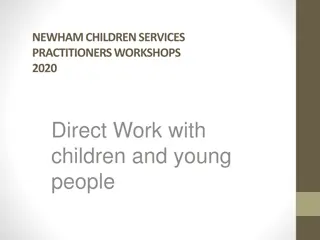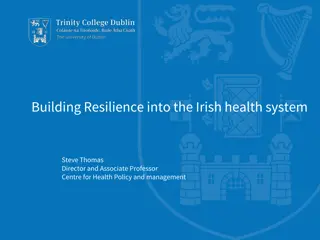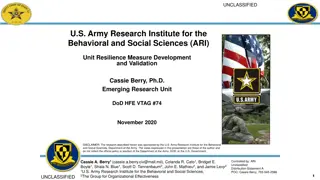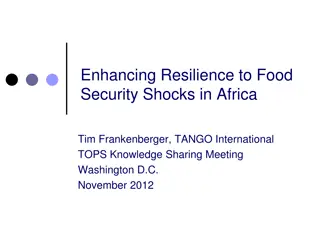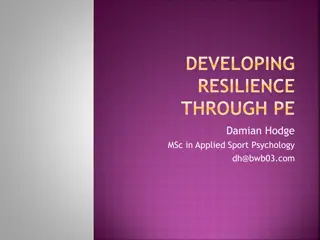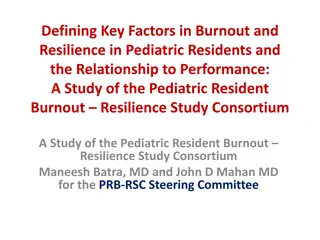Building Resilience in Children & Young People: A Parent's Guide
Resilience in children and young people is essential for their mental well-being and ability to bounce back from challenges. This guide provides insights on nurturing resilience through relationships, social support, encouraging help-seeking behavior, and developing coping strategies.
Download Presentation

Please find below an Image/Link to download the presentation.
The content on the website is provided AS IS for your information and personal use only. It may not be sold, licensed, or shared on other websites without obtaining consent from the author. Download presentation by click this link. If you encounter any issues during the download, it is possible that the publisher has removed the file from their server.
E N D
Presentation Transcript
Building Resilience in Children & Young people A helpful guide for parents
Resilience Mental wellbeing is all about feeling good and functioning well. According to research one of the key factors that determine your ability to deal with adversity if your ability to bounce back when things are tough. Resilience: Helps you try new things Encourages you to take on new challenges Keeps you going when things get tough Keeps your dreams alive Helps you deal with failure and frustration Gives you the strength to get up and try again Gives you a Why to keep going
Building Resilience in Children Resilience is being able to bounce back from stress, challenge, tragedy, trauma or adversity. When children/young people are resilient, they are braver, more curious, more adaptable, and more able to extend their reach into the world. Resilience is something that can be nurtured in all children and young people.
1. Resilience needs relationships, not uncompromising independence The reliable presence of at least one supportive relationship according to research helps a child/young person become more resilient. In the context of a loving relationship with a caring adult, they have the opportunity to develop vital coping skills.
2. Increase their exposure to people who care about them Social support is associated with higher positive emotions, motivation, optimism a sense of personal control, self-esteem, and resilience. Children and young people don t always notice the people around them who are supporting them, in their corner cheering them on. It s important to let them know about the people in their life who are there for them. Anything you can do to build their connections with the people who love them will strengthen them.
3. Let them know that its okay to ask for help Children and young people will often have the idea that being brave is about dealing with things by themselves. Let them know that being brave and strong means knowing when to ask for help.
4. Build their executive functioning It is important for children and young people to be able to develop coping strategies. Helping a child manage their own behaviour and feelings will help a child increase their own capacity to do this. Ways of helping include: Establishing routines Modelling healthy social behaviour Creating and maintaining supportive reliable relationships around them Providing opportunities for their own social connections Creative play including board games, exercise, games that involve memory. These can give a child the opportunity to think and act independently, and can provide opportunities for them to make their own decisions.
5. Encourage a regular mindfulness practice Mindfulness creates structural and functional changes in the brain that support a healthy response to stress. Mindfulness for children and young people generally works best if it s kept to about five minutes or less. Some children and young people can enjoy mindfulness for longer. There are lots of websites around mindfulness for children and young people. There are some websites that may be of interest listed in the reference section.
Some simple mindfulness activities that you might like to try: The Mindful Jar/bottle Making a mindful bottle/jar can help children and young people to understand what happens when they have big emotions and it can also help a child/young person to find calm when they are feeling stressed, upset or overwhelmed. Start with an empty drinks bottle or jar and fill it up to the top with water. Add some glitter. Add a few drops of glue to the bottle/jar and give it shake Ribbons or buttons can be added too to express different feelings. Explaining that the glitter can be like a child s thoughts when they are upset, angry or stressed, and watching how they can whirl around quickly can be likened to how a child can t think clearly when they are upset. Once the bottle/jar is still, the water settles and it help explains that when a child is calm, thoughts start to settle, and everything can become clearer. It s a lovely activity to do, as whilst the child is thinking and learning about their own emotions, they are also practicing mindfulness as they are in the moment watching the glitter and buttons fall to the bottom of the bottle/jar. It can be relaxing and used as a calming activity too.
Mindful smelling You can use lots of different things you have around the house such as flowers, grass, candles, herbs. The child/young person can be invited to breathe in the smell and to feel what happens to their body. Sometimes, for example, grass might remind a child/young person of a day at the park or a picnic in the garden.
A Mindful walk Taking a short walk together to help children and young people to learn to be mindful while they re moving. Ask the child/young person to focus on their breath. Then to focus on their other senses, e.g to feel the breeze against their skin, the sound of the trees, the smell of fresh air, the way their body feels as they move. The idea is for them to experience the sensations rather than just think about them.
6. Exercise Exercise strengthens and reorganizes the brain to make it more resilient to stress. Examples that are great for children and young people: Throwing a frisbee Kicking a ball Hula hoops Dancing Walking the dog
7. Build feelings of competence and a sense of mastery Reminding a child/young person that they can do hard things, and by acknowledging their strengths, the brave things they do, their effort when they do something difficult, and when you encourage them to make their own decision helps nurture those feelings of competency. This can help a child/young person to be less likely to be reactive to future stress and more likely to handle future challenges.
8. Nurture Optimism One of the key characteristics of resilient people is optimism. If you have a child/young person who tends to look at the glass as being half empty, show them a different view. This doesn t mean invalidating how they feel. Acknowledge their view of the world and introduce them to a different one.
9. Teach them how to reframe The ability to reframe challenges in ways that feel less threatening is linked to resilience. Reframing is such a valuable skill to have. In times of difficulty or disappointment, it will help children/young people focus on what they have, rather than what they ve lost. To build this skill, acknowledge their disappointment, then gently steer them away from looking at what the problem has cost them, towards the opportunities it might have brought them.
10. Model resiliency Imitation is such a powerful way to learn. Bringing children/young people into your emotional world at appropriate times will help them to see that feelings such as sadness, feeling stuck, and disappointment are all very normal human experiences. When experiences are normalized, there will be a safety and security that will open the way for them to explore what those experiences mean for them, and experiment with ways to respond.
11. Facing fear but with support Facing fear is so empowering, but to do this, children/young people need the right support. When they are faced with something difficult, children/young people can feel there are only two choices. To face it head on or avoid it. There is a third option, to be able to move gradually towards it, while feeling supported and with a certain amount of control.
12. Encourage them to take safe, considered risks Let them know that the courage they show in doing something brave and difficult is more important than the outcome. Age appropriate freedom lets them learn about themselves, encourages them to think about their decisions, and teaches them that they can cope with the things that go wrong.
13. Dont rush to their rescue It is in the precious space between falling and standing back up again that children learn how to find their feet. Of course, sometimes scooping them up and giving them a steady place to be is exactly what they need to find the strength to move forward. The main thing is not to do it every time. Exposure to stressors and challenges that they can manage during childhood will help to ensure that they are more able to deal with stress during adulthood.
14. Meet them where they are Resilience isn t about never falling down. It s about getting back up again, and there s no hurry for this to happen. All of us experience emotional pain, setback, grief and sadness sometimes. Feelings always have a good reason for being there, even if they can feel a little uncomfortable at times. The key for children/young people is to learn to respect those feelings (even the bad ones), but not let them take charge and steer towards trouble. Sadness and grief, for example, can make us want to withdraw for a little while. It is during the withdrawal that information is reflected upon, assimilated and processed so that balance can be found again. If this is rushed, even if it is in the name of resilience, it can stay as a gently rumble and show up through behaviour, sometimes at unexpected times.
15. Nurture a growth mindset. We can change, and so can other people Research has found that children and young people who have a growth mindset, the belief that people have the potential to change, are more likely to show resilience when things get tough. Children and young people who believe that people can change report less anxiety and stress, better feelings about themselves in response to social exclusion, and better physical health.
16. Let them know that you trust their capacity to cope Fear of failure isn t so much about the loss but about the fear that they (or you) won t be able to cope with the loss. What you think matters, If you believe they have it in them to cope with the stumbles along the way, they will believe this too. This isn t always easy. It can be heartbreaking when they struggle or miss out on something they want, not because of what it means for us, but because of what we know it means for them. But they ll be okay. However long it takes, they ll be okay. When you decide, they ll decide.
17. Build their problem solving toolbox Self talk is such an important part of problem solving. Your words are powerful because they are the foundation on which they build their own self talk. Rather than solving their problems for them, start to give them the language to solve their own. Some ideas: What would (someone who they see as capable) do? What has worked before? Say as many ideas as you can in two minutes, even the silly ones? How can we break this big problem into little pieces
: 18. Make time for creativity and play Problem solving is a creative process. Anything that strengthens their problem solving skills will nurture their resilience. Children and young people are naturally curious, inquisitive and creative. Give them space and the time to play and get creative, and they ll do the rest.
Some creative activities: CLOSE YOUR EYES AND IMAGINE YOU ARE OUTSIDE IN A BEAUTIFUL PLACE. WHERE ARE YOU? A MEADOW, A FOREST, ON THE BEACH? WHO WOULD YOU LIKE TO BE WITH OR WOULD YOU RATHER BE ON YOUR OWN? WHAT SOUNDS DO YOU THINK YOU CAN HEAR? DRAW OR WRITE YOUR NATURE DAYDREAM BELOW NATURE DAYDREAM
Write down all the things that are important to you. You could write the most important things at the trunk of the tree and then work your way up.
Wellbeing Bookmark Fold up an A4 piece of paper in to a bookmark. Or use a piece of cardboard and decorate it. Write down what you do to look after your wellbeing, e.g. walking in the park, playing with friends, painting, reading and so on. Once its finished add a ribbon if you like along with cellotape to strengthen the bookmark.
20. Let them talk Try to resist solving their problems for them. Instead, be the sounding board as they take themselves to wherever they need to be. As they talk, their mind is processing and strengthening. Wherever you can, let them talk and try to come up with their own solutions. Problem solving is an important skill to have.
21. Try, how, not why When things go wrong, as they will, asking children why will often end in don t know . Who knows why any of us do silly things or make decisions that aren t great ones. The only certainty is that we all do them. Encourage problem solving and reflection instead by asking how they can put it right.
References Building Resilience in Children 20 Practical, Powerful Strategies (Backed by Science) Heysigmund.com, Posted by Karen Young Liverpoolcamhs.com Resilience framework Promoting Emotional resilience 2008 West Sussex County Council Ordinary magic: Resilience processes in development. Masten A.S. 2001. American Psychologist, 56(3), 227-238. 3 Rutter, 1995. Cited in Resilient Therapy, Hart, Blincow and Thomas, Routledge 2007
Useful websites Building resilience in Young Children www.resources.beststart.org Building resilience in children aged 0-12 www.resources.beyondblue.org.au Enhancing resilience www.cedar.exeter.ac.uk Promoting Emotional resilience www.hbtg.org.uk Big life journal resources www.biglifejournal-uk.co.uk CAMHS www.camhs-resources.co.uk






